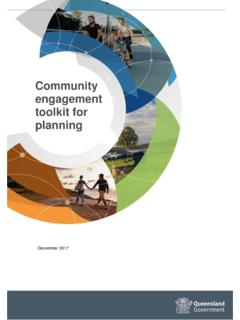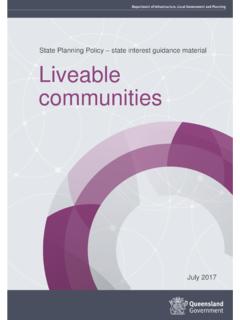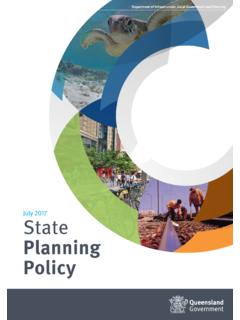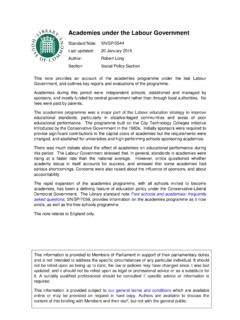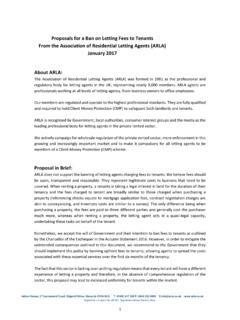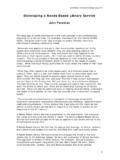Transcription of South East Queensland Regional Plan 2017 ShapingSEQ
1 South east Queensland Regional plan 2017 ShapingSEQ Background paper 1: Grow September 2017 ShapingSEQ background paper 1: grow theme Page 2 of 59 State of Queensland , September 2017 . Published by the Department of Infrastructure, local government and Planning, 1 William Street, Brisbane Qld 4000, Australia. Licence: This work is licensed under the Creative Commons CC BY Australia Licence. In essence, you are free to copy and distribute this material in any format, as long as you attribute the work to the State of Queensland (Department of Infrastructure, local government and Planning) and indicate if any changes have been made. To view a copy of this licence, visit Attribution: The State of Queensland , Department of Infrastructure, local government and Planning.
2 The Queensland government supports and encourages the dissemination and exchange of information. However, copyright protects this publication. The State of Queensland has no objection to this material being reproduced, made available online or electronically but only if it is recognised as the owner of the copyright and this material remains unaltered. The Queensland government is committed to providing accessible services to Queenslanders of all cultural and linguistic backgrounds. If you have difficulty understanding this publication and need a translator, please call the Translating and Interpreting Service (TIS National) on 131 450 and ask them to telephone the Queensland Department of Infrastructure, local government and Planning on 13 QGOV (13 74 68). Disclaimer: While every care has been taken in preparing this publication, the State of Queensland accepts no responsibility for decisions or actions taken as a result of any data, information, statement or advice, expressed or implied, contained within.
3 To the best of our knowledge, the content was correct at the time of publishing. Any references to legislation are not an interpretation of the law. They are to be used as a guide only. The information in this publication is general and does not take into account individual circumstances or situations. Where appropriate, independent legal advice should be sought. An electronic copy of this report is available on the Department of Infrastructure, local government and Planning s Queensland planning system website at ShapingSEQ background paper 1: grow theme Page 3 of 59 Contents Introduction .. 6 Purpose .. 6 Theme defined .. 6 Relationship with other themes .. 7 Context .. 8 Previous Regional policy .. 8 Development of consolidation and expansion areas .. 10 Urban Footprint .. 12 Rural Living Area.
4 13 Regional Landscape and Rural Production Area .. 13 Integration with local government planning schemes .. 14 Population and dwelling projections .. 14 Trends in dwelling and lot types .. 17 Performance against 2009 dwelling targets .. 19 Opportunities and challenges .. 23 Reduced pressure on natural resources .. 23 Reduced cost of living and transportation .. 24 Efficient provision of infrastructure .. 25 Improved urban amenity and economic prosperity .. 26 Discretionary rural (family) subdivision .. 26 Increased fragmentation of rural land .. 29 Increased conflict between rural and urban uses .. 29 Decreased flexibility of rural land uses .. 29 Detrimental effects on ecological and scenic values .. 29 Decreased stability of related long-term rural processing facilities .. 29 Increased land valuations.
5 30 Increased pressure on rural infrastructure .. 30 Increased service costs for local governments .. 30 Providing other options .. 31 Policy directions in ShapingSEQ .. 32 Efficient land 32 Measuring land supply: capacity versus realistic take-up .. 32 Expansion land .. 32 Existing expansion supply .. 33 Underutilised Urban Footprint .. 34 Consolidation supply .. 35 Growth scenarios .. 35 The 2041 planning horizon .. 35 Alternative growth scenarios and growth allocations .. 36 Preferred settlement pattern .. 37 Allocation of consolidation .. 38 Additional expansion areas .. 39 Housing types .. 40 Land to accommodate employment projections .. 40 Retained expansion capacity .. 40 SEQ at seven million .. 41 Focusing density in public transport corridors and around centres .. 42 New communities: compact settlement in expansion development.
6 44 ShapingSEQ background paper 1: grow theme Page 4 of 59 Housing diversity and the missing middle .. 45 Growing rural towns and villages .. 46 Discretionary rural (or family) subdivision .. 47 Available alternative options .. 47 Accommodating family on-site .. 47 Rural residential development .. 47 Rural Living Areas .. 47 Conclusion .. 48 Appendix A: Existing Urban Area (EUA) .. 49 South east Queensland Regional plan 2005 2026 .. 49 South east Queensland Regional plan 2009 2031 .. 49 ShapingSEQ .. 49 Appendix B: Capacity and expected take-up of greenfield dwellings to 2041 .. 50 Appendix C: Minimum years of supply benchmarks current practice .. 53 53 Sydney .. 53 Melbourne .. 53 Adelaide .. 54 Perth .. 54 American Planning Association .. 54 United Kingdom .. 54 Appendix D: Constraints.
7 55 State constraints .. 55 local government constraints .. 56 Appendix E: Urban corridor identification methodology .. 58 List of tables Table 1: Consolidation and expansion targets in Australian metropolitan regions .. 12 Table 2: Additions to the Urban Footprint and equivalent changes, 2005 to 2016 .. 13 Table 3: Projected population growth and required dwellings in SEQ 2011 2041 (medium series) .. 15 Table 4: Total dwelling targets compared to building approvals and actual net dwelling growth to 2016 .. 20 Table 5: Infill dwelling targets compared to building approvals and actual net dwelling growth to 2016 .. 21 Table 6: Greenfield dwelling targets compared to building approvals and actual net dwelling growth to 2016 .. 22 Table 7: Factors affecting take-up rates .. 32 Table 8: Scenarios considered for dwelling supply needs in SEQ.
8 36 Table 9: Dwelling supply benchmarks to 2041 .. 38 Table 10: Expansion capacity in 2011 and expected remaining capacity in 2041 .. 41 Table 11: Land and dwellings required at seven million .. 42 Table 12: Indicative residential densities in and around Regional activity centres .. 44 Table 13: State datasets .. 55 Table 14: local datasets .. 56 ShapingSEQ background paper 1: grow theme Page 5 of 59 List of figures Figure 1: South east Queensland region .. 6 Figure 2: SEQRP Regional land use categories (2009) .. 9 Figure 3: Existing urban area .. 11 Figure 4: Population growth and projections in SEQ 2001 2041 .. 15 Figure 5: Capital city gross population density (urban centres and localities, 2015) .. 18 Figure 6: Total dwelling approvals (2006-2016) vs pro-rata identified SEQRP total dwelling target (2006 2031).
9 20 Figure 7: Infill dwelling approvals (2006-2016) vs pro-rata SEQRP infill dwelling targets (2009 2031) .. 21 Figure 8: Subdivision outside the Urban Footprint .. 28 Figure 9: Major expansion areas in SEQ 2009-2015 .. 34 Figure 10: Expansion dwelling task scenario comparison .. 37 ShapingSEQ background paper 1: grow theme Page 6 of 59 Introduction Purpose The purpose of this paper is to inform, support and provide background material for the policy and implementation provisions of the South east Queensland Regional plan 2017 , called ShapingSEQ , in relation to the grow theme. This theme considers the preferred pattern of settlement to best manage projected Regional growth in South east Queensland (SEQ). Another four interrelated background papers have been prepared to support ShapingSEQ including those covering the themes of: Connect considering the infrastructure demands and integrating land use and transport planning to improve outcomes in the region.
10 Prosper considering the approach to supporting improved economic and employment outcomes for the region Sustain considering issues for the protection and management of our natural environment and sustainable social outcomes for our communities Live looking at ways to improve the quality of design and amenity in our urban areas. Combined, the papers provide the foundation upon which ShapingSEQ has been prepared. Theme defined SEQ is the third most populated metropolitan region in Australia, and is home to over 71 per cent of all Queenslanders, with a population of about million in 2016. Recent projections indicate sustained, high levels of population growth over the next 25 years, with the region expected to reach a population of million people by 2041. The way in which we guide the region s pattern of urban development is central to managing this growth in an economically, environmentally and socially sustainable way.
